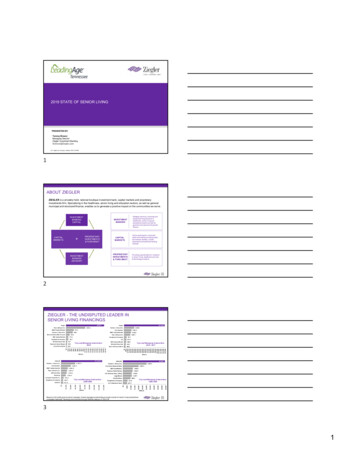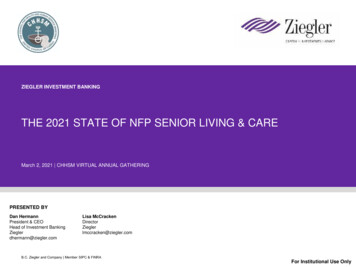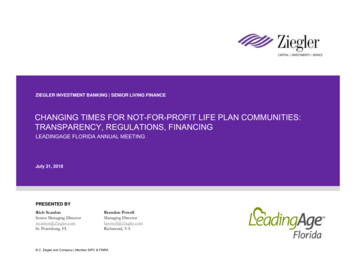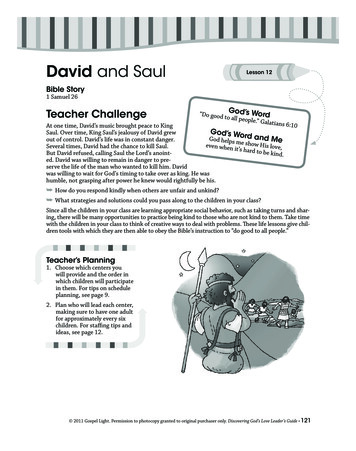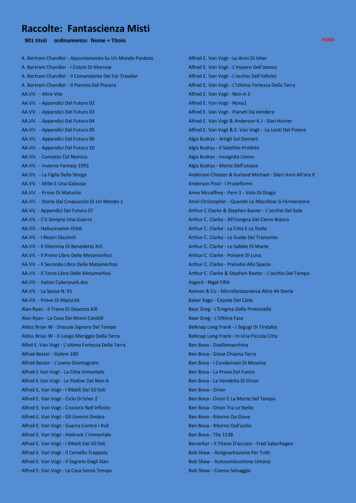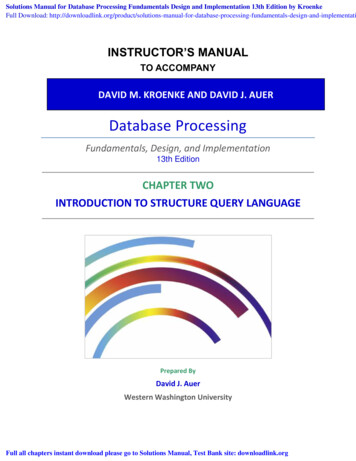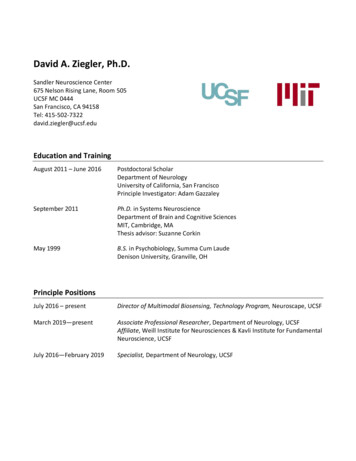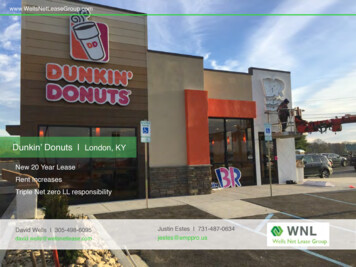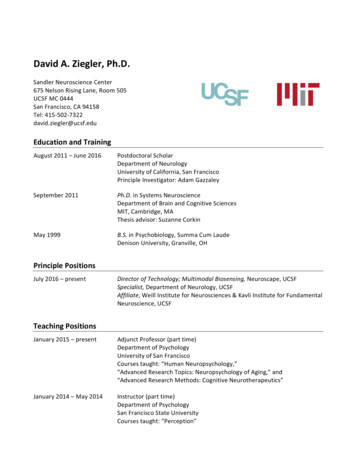
Transcription
David A. Ziegler, Ph.D.Sandler Neuroscience Center675 Nelson Rising Lane, Room 505UCSF MC 0444San Francisco, CA 94158Tel: 415-502-7322david.ziegler@ucsf.eduEducation and TrainingAugust 2011 – June 2016Postdoctoral ScholarDepartment of NeurologyUniversity of California, San FranciscoPrinciple Investigator: Adam GazzaleySeptember 2011Ph.D. in Systems NeuroscienceDepartment of Brain and Cognitive SciencesMIT, Cambridge, MAThesis advisor: Suzanne CorkinMay 1999B.S. in Psychobiology, Summa Cum LaudeDenison University, Granville, OHPrinciple PositionsJuly 2016 – presentDirector of Technology; Multimodal Biosensing, Neuroscape, UCSFSpecialist, Department of Neurology, UCSFAffiliate, Weill Institute for Neurosciences & Kavli Institute for FundamentalNeuroscience, UCSFTeaching PositionsJanuary 2015 – presentAdjunct Professor (part time)Department of PsychologyUniversity of San FranciscoCourses taught: “Human Neuropsychology,”“Advanced Research Topics: Neuropsychology of Aging,” and“Advanced Research Methods: Cognitive Neurotherapeutics”January 2014 – May 2014Instructor (part time)Department of PsychologySan Francisco State UniversityCourses taught: “Perception”
David A. Ziegler – CV 2Research Positions2001 – 2004Senior Research AssistantCenter for Morphometric Analysis, Department of NeurologyMassachusetts General Hospital, Boston, MAPrinciple Investigators: Martha R. Herbert & Verne S. CavinessProfessional Societies Organization for Human Brain MappingSociety for NeuroscienceCognitive Neuroscience SocietySigma XiPsi Chi2005 – present2002 – present2001 – 20031997 – 20011997 – 2001Honors and Awards Advanced Psychometrics in Cognitive Aging Workshop Award, Friday Harbor, WA (2015 & 2017)UCSF School of Medicine Technology Transformation Grant Recipient (2014)Organization for Human Brain Mapping Trainee Abstract Travel Award (2013)NIH Loan Repayment Program (2012-present)UCSF Postdoctoral Travel Award (2012)Angus MacDonald Award for Excellence in Undergraduate Teaching (MIT; 2011)Advanced Multimodal Neuroimaging Training Program Fellowship (MIT/MGH; 2007-2009)Honorable Mention, NSF Graduate Research Fellowship Program (2005)Précis Presidential Fellowship (MIT; 2004-2005)Young Investigator Scholarship, UC Davis Epilepsy and Autism Conference (2004)John Merck Fund scholarship to attend Cold Spring Harbor course “Neurobiology ofDevelopmental Disorders” (Summer 2002)President's Medal (Denison University; 1999)Distinguished Leadership Award (Denison University; 1999)Irvine Wolf Prize in Psychology (Denison University; 1999)Anderson Summer Research Fellowship, (summer 1997 & 1998)Denison University Trustee Award (4 years; 1995-1999)Phi Beta Kappa (1999-present)Department of Psychology Fellow (Fall 1998-May 1999)Mortar Board, member (1998-present)Omicron Delta Kappa, member (1998-present)Ad Hoc Referee Brain Structure and FunctionCerebral CortexCognitive, Affective, and BehavioralNeuroscienceJournal of Neurology, Neurosurgery, andPsychiatryJournal of NeuroscienceJournal of Parkinson’s Disease Journal of the American AgingAssociation (AGE)Neurobiology of AgingNeuroImageNeurologyNeuroscience LettersParkinsonism & Related DisordersPLoS ONETranslational Neuroscience
Invited LecturesDateOrganizationLecture SeriesTitleDec 2017UCSF Osher Centerfor IntegrativeMedicineOCIM Research SeminarA neuroplasticity-based approach toenhancing internal attentionDec 2016Center for PracticalWisdom, Universityof ChicagoEssential Self TechnologyNetwork meetingCognitive Neurotherapeutic Approachesto Enhancing Attention and SelfRegulationNov 2016InternationalSymposium onContemplativeStudiesSymposium: QuantifyingInteroceptionQuantifying Interoception:A neuroplasticity-based approach tomeditation training in novicesNov 2015University of SanFranciscoNeuroscience MinorLecture SeriesDynamics and plasticity of attention andself-regulation in healthy agingJune2015UCSF MedicalSchoolTraining the Mind SeminarSeriesTraining internal attention with a novelmeditation gameApril2013Cognitive AgingConference(Dortmund, DE)Symposium on oscillationsin aging (organizer andchair)The effects of aging on white matter andcognitive rhythmsDec 2012MITSymposium honoring SueCorkin’s careerCognitive control networks in the agingbrainJune2012Nov 2011InternationalSymposium on Aging andNeuropsychologicalMCISociety (Oslo, NO)Mills College LifespanMills CollegeDevelopment LectureSeriesCognitive control networks in the agingbrainStructural and functional integrity ofcognitive control networks in healthyagingCognition in healthy aging: Structural andfunctional integrity of neural circuits thatsupport memory and attentionUnmasking heterogeneity in Parkinson’sdisease: Novel MRI and cognitivemeasuresMar 2011MGHMoshe Bar Lab MeetingFeb 2007MGHMovement Disorders UnitLecture SeriesMar 2006MITBrainLunchWhite or gray: Which matter mattersmore in healthy aging?Colby CollegeDepartment ofMathematics ColloquiumSeriesA bit more here, a bit less there: Factoranalyzing brain volumes in autismOct 2003
David A. Ziegler – CV 2Teaching Experience Guest Lecturer, Neural Basis of Learning and Memory (MIT, 9.03)Title: “Imaging the human brain”Instructors: Suzanne Corkin and Matthew WilsonFall 2005 Teaching Assistant, Introduction to Psychology (MIT, 9.00)Instructor: Jeremy WolfeSpring 2006 Guest Lecturer, Cognitive Neuroscience (MIT, 9.10)Title: “Neural plasticity in adult brains: From synapses to cognitive networks”Instructor: Suzanne CorkinSpring 2006 Teaching Assistant, Cognitive Processes (MIT, 9.65)Instructor: Molly PotterSpring 2007 Guest Lecturer, Neural Basis of Learning and Memory (MIT, 9.03)Title: “Neuroimaging techniques for studying learning and memory”Instructors: Suzanne Corkin and Matthew WilsonFall 2007Fall 2009 Guest Lecturer, Cognitive Processes (MIT, 9.65)Title: “Implicit and explicit memory: Evidence for multiple memory systemsin the brain?” Instructor: Molly PotterSpring 2008Spring 2009 Teaching Assistant, Cognitive Neuroscience (MIT, 9.10)Instructor: Suzanne CorkinLectures:“Neuroimaging techniques for studying cognitive processes”“Working memory and cognitive control processes”Fall 2008Fall 2010 Teaching Fellow, The Human Mind (Harvard University, SB-62)Instructor: Steven PinkerSpring 2009 Teaching Fellow, Psychological Science (Harvard University, SLS-20)Instructor: Steven PinkerFall 2009 Guest Lecturer, Cognitive Neuroscience (San Francisco State University)Title: “Working memory and cognitive control processes”Instructor: Joaquin AngueraJuly 2012 Guest Lecturer, Cognitive Neuroscience (San Francisco State University)Title: “Working memory and cognitive control processes”Title: “Who’s doing the Thinking? Techniques in Cognitive Neuroscience”Instructor: Judy PaMay 2013Sept 2013 Adjunct Professor, Perception (Psych 492; San Francisco State University)Spring, 2014 Adjunct Professor, Advanced Research Topics: Neuropsychology of Aging(PSYC 387; University of San Francisco)2015-present Adjunct Professor, Human Neuropsychology(PSYC 351; University of San Francisco)2015-present Adjunct Professor, Advanced Research Methods: Cognitive Neurotherapeutics(PSYC 388; University of San Francisco)2016-present
David A. Ziegler – CV 3PublicationsZiegler DA, Ashourian P , Wonderlick JS, Hansen LA, Koppuzha CC, Scherzer CR, Corkin S. (in preparation).Neuroanatomical and genetic underpinnings of formed and benign hallucinations in idiopathicParkinson’s disease.Ziegler DA, Ashourian P, Wonderlick JS, Sarakhan Ak, Prelec D, Scherzer CR, Corkin S. (in preparation).DRD2 polymorphisms confer increased risk of behavioral impulsivity in Parkinson Disease.Ziegler DA, Rubens, MT, Janowich, J, Warbrick T., Zanto TP, and Gazzaley A. (in preparation). Neuralcorrelates of age-related changes in fluctuations of attention: A simultaneous EEG/fMRI study.Ziegler DA, Ashourian P, Griffith EY, Hansen LA, Hämäläinen M, Corkin S. (in revision). Age-relatedchanges in white matter integrity disrupt top-down modulation of oscillations during visual search.Ziegler DA, Janowich J, Gazzaley A. (2018). Differential Impact of Interference on Internally- andExternally-Directed Attention. Scientific Reports, 8(1):2498.Simon AJ, Skinner SN, Ziegler DA. (2016). Training Working Memory: Anatomy Matters. Journal ofNeuroscience. 36(30):7805-6.Ziegler DA, Mishra J, Gazzaley A. (2015). The acute and chronic impact of technology on our brain. in L.D.Rosen, L.M. Carrier, N.A. Cheever (Ed.), The Handbook of Psychology, Technology and Society.Ziegler DA and Corkin S. (2014). New magnetic resonance imaging biomarkers advance thecharacterization of Parkinson’s disease. European Neurological Review, 9(1):86-89.Ziegler DA, Ashourian P, Wonderlick JS, Sarokhan AK, Prelec D, Scherzer CR, Corkin S (2014). MotorImpulsivity in Parkinson Disease: Associations with COMT and DRD2 polymorphisms. Scand J Psychol,55(3): 278-86.Mishra J, Anguera JA, Ziegler DA, Gazzaley A. (2013). A cognitive framework for understanding andimproving interference resolution in the brain. Prog Brain Res, 207:351-77.Ziegler DA and Augustinack JC. (2013). Harnessing advances in structural MRI to enhance research onParkinson’s disease. Imaging in Medicine, 5(2): 91-94.Ziegler DA, Wonderlick JS, Ashourian P, Hansen LA, Young JC, Murphy AJ, Kopuzha CK, Growdon JH,Corkin S. (2013). Substantia nigra volume loss before basal forebrain degeneration in earlyParkinson disease. JAMA Neurology, 70(2), 241-247.Ziegler DA and Corkin S. (2013). New MRI biomarkers advance the characterization of Parkinson disease.US Neurology, 9: 8–12.O'Brien LM, Ziegler DA, Herbert MR, Deutsch CK, Frazier JA. (2011). Adjustment for head size differencesin volumetric MRI studies: theoretical issues and practical implications. Psychiatry Research:Neuroimaging, 193(2): 113-122.Ziegler DA, Piquet O, Salat DH, Prince K, Connally E, Corkin S. (2010). Cognition in healthy aging is relatedto regional white matter integrity, but not cortical thickness. Neurobiol Aging, 31(11): 1912-26.Ziegler DA, Pritchett DL, Hosseini-Varnamkhasti P, Corkin S, Hämäläinen M, Moore CI, Jones SR. (2010).Transformations in oscillatory activity and evoked responses in primary somatosensory cortex inmiddle age: A combined computational neural modeling and MEG study. Neuroimage, 52(3): 897-912.Wonderlick JS, Ziegler DA, Hosseini-Varnamkhasti P, Bakkour A, van der Kouwe A, Triantafyllou C, CorkinS, Dickerson BC. (2009). Reliability of MRI-derived cortical and subcortical morphometric measures:Effects of pulse sequence, voxel geometry, and parallel imaging. Neuroimage, 44(4): 1324-33.Wrase J, Makris N, Braus DF, Mann K, Smolka MN, Kennedy DN, Caviness VS, Hodge SM, Tang L, AlbaughM, Ziegler DA, Davis OC, Kissling C, Schumann G, Breiter HC, Heinz A. (2008). Amygdala volumeassociated with alcohol abuse relapse and craving. Am J Psychiatry, 165(9). 1179-84.
David A. Ziegler – CV 4O’Brien LM, Ziegler DA, Deutsch CK, Kennedy DN, Goldstein J, Seidman L, Hodge S, Makris N, CavinessVS, Frazier J, Herbert MR. (2006). Adjustment for whole brain and cranial size in volumetric brainstudies: a review of common adjustment factors and statistical methods. Harvard Review ofPsychiatry, 14. 141-151.Herbert MR, Ziegler DA, Deutsch CK, O'Brien LM, Kennedy DN, Filipek PA, Bakardjiev A, Hodgson J,Takeoka M, Makris N, Caviness VS Jr. (2005). Brain asymmetries in autism and developmentallanguage disorder: A nested multi-level analysis. Brain, 128. 213-226.Herbert MR, Ziegler DA. (2005). Volumetric neuroimaging and low-dose early-life exposures: Loosecoupling of pathogenesis-brain-behavior links. Neurotoxicology, 26(4): 565-572.Herbert MR, Ziegler DA, Makris N, Filipek PA, Normandin JJ, Sanders HA, Kennedy DN, Caviness VS Jr.(2004). Localization of white matter volume increase in autism and developmental language disorder.Annals of Neurology, 55. 530-540.Herbert MR & Ziegler DA (2004). White matter volume increase and minicolumns in autism—Reply.Annals of Neurology, 56(3). 454.Makris N, Gasic GP, Seidman, LJ, Goldstein JM, Gastfriend DR, Elman I, Albaugh DM, Hodge SM, ZieglerDA, Sheahan F, Caviness VS Jr, Tsuang MT, Kennedy DN, Hyman SE, Rosen BR, Brieter HC. (2004).Decreased absolute amygdala volume in cocaine addicts. Neuron, 44. 729-740.De Fosse L, Hodge SM, Makris N, Kennedy DN, Caviness VS Jr, McGrath L, Steele S, Ziegler DA, HerbertMR, Frazier J, Tager-Flusberg H, Harris GJ. (2004). Language-association cortex asymmetry in autismand specific language impairment. Annals of Neurology, 56(6). 757-766.Herbert MR, Ziegler DA, Deutch CK, O’Brien LM, Lange NT, Bakardjiev A, Hodgson J Adrien KT, Steele S,Makris N, Kennedy DN, Harris GJ, Caviness VS Jr. (2003). Dissociations of cerebral cortex, subcortical,and cerebral white matter volumes in autistic boys. Brain, 126 (5). 1182-1192.Herbert MR, Ziegler DA, Makris N, Bakardiev A, Hodgson J, Adrien KT, Kennedy DN, Harris GJ, & CavinessVS. (2003). Larger brain and white matter volumes in children with developmental language disorder.Developmental Science, 6(4). F11-F22.Herbert MR, Ziegler DA, Kennedy DN, Makris N, Caviness VS Jr. (2003). MRI structural neuroimaging ofautism and developmental language disorder: A review and commentary. In: Advances in ClinicalNeurosciences 2003, Singh K.K. & Chandra P., eds. Association of Neuroscientists of Eastern India,Ranchi 2003.Herbert MR, Harris GJ, Adrien KT, Ziegler DA, Makris N, Kennedy DN, Lange NT, Chabris, CF, Bakardjiev A,Hodgson J, Takeoka M, Tager-Flusberg H, Caviness VS Jr. (2002). Abnormal asymmetry in languageassociation cortex in autism. Annals of Neurology, 52. 588-596.Pollard JW, Freeman JE, Ziegler DA, Hersman MN, & Goss CW. (2000). Predictions of normative drug useby college students: False consensus, false uniqueness, or just plain accuracy? Journal of CollegeStudent Psychotherapy, 14. 5-12.Conference AbstractsSimon AJ, Campusano R, Volponi J, Skinner S, Anguera J, Gazzaley A, Ziegler DA. (2018). Dynamics ofparietal lobe activity predict variability in sustained attention. Abstract presented at the annualmeeting of the Cognitive Neuroscience Society.Ziegler DA, Skinner SN, Simon A, Gazzaley A. (2017). Meditation-Inspired Cognitive Training ImprovesWorking Memory and Increases Cortical Thickness. Abstract presented at the annual meeting of theOrganization for Human Brain Mapping.Skinner SN, Simon AJ, Ziegler DA, Gazzaley A. (2016). Internal attention training improves workingmemory and distractor suppression in young adults. 2016 Neuroscience Meeting Planner.Washington, DC: Society for Neuroscience, 2016. Online.
David A. Ziegler – CV 5Ziegler DA, Janowich J, Gazzaley A. (2015). Dynamic Interplay between distractions and internally- andexternally-directed attention. Annual Meeting of the International Neuropsychological Society,Denver, CO.Ziegler DA, Ashourian P, Wonderlick JS, Sarakhan Ak, Prelec D, Scherzer CR, Corkin S. (2015). DRD2polymorphisms confer increased risk of behavioral impulsivity in Parkinson Disease. Annual Meetingof the International Neuropsychological Society, Denver, CO.Ziegler DA, Janowich J, Gazzaley A. (2014). Dynamics and plasticity of self-regulating internal attention.Bay Area Memory Meeting, Palo Alto, CA.Ziegler DA, Rubens, MT, Janowich, J, Warbrick T., Zanto TP, and Gazzaley A. (2013). Neural correlates ofage-related changes in fluctuations of attention. 2013 Neuroscience Meeting Planner. Washington,DC: Society for Neuroscience, 2013. Online.Ziegler DA, Ashourian P, Griffith EY, Hansen LA, Hämäläinen M, Corkin S. (2013). White matter damagein healthy aging disrupts neural oscillations underlying top-down attention. Oral presentation andposter at the 2013 annual meeting of the Organization for Human Brain Mapping.Ziegler DA and Gazzaley A. (2013). Effects of age and external noise on self-regulation of internaldistractions. Cognitive Neuroscience Society annual meeting.Ziegler DA, Finnegan CB, Gazzaley A. (2013). Meditation-inspired cognitive training promotes selfregulation of internal distractions. Entertainment Software & Cognitive Neurotherapeutics Society(ESCoNS) Conference.Ziegler DA, Wonderlick JS, Hansen LA, Young JC, Ashourian P, Growdon JH, Corkin S. (2011). Newmultispectral MRI tools reveal stage-dependant decreases in basal forebrain and substantia nigravolumes in early Parkinson's disease. Program No. 49.17. 2011 Neuroscience Meeting Planner.Washington, DC: Society for Neuroscience, 2011. Online.Ziegler DA, Hosseini P, Griffith EY, Hansen LA, Hämäläinen M, Corkin S. (2010). Age-related changes inoscillatory dynamics associated with visual attention. Program No. 605.4. 2010 Neuroscience MeetingPlanner. San Diego, CA: Society for Neuroscience, 2010. Online.Hosseini P, Ziegler DA, Wonderlick JS, Hansen LA, Koppuzha CC, Scherzer CR, Corkin S. (2010).Neuroanatomical underpinnings of formed and benign hallucinations in idiopathic Parkinson’s disease.Program No. 51.14. 2010 Neuroscience Meeting Planner. San Diego, CA: Society for Neuroscience,2010. Online.Ziegler DA, Wonderlick JS, Murphy AJ, Fischl B, Growdon JH, Corkin S. (2009). Automatically segmentingmidbrain structures using new multispectral MRI tools: Method and application to Parkinson’sdisease. Poster presented at the 15th annual meeting of the Organization for Human Brain Mapping.Ziegler DA, Wan Q, Pritchett DL, Kerr CE, Corkin S, Moore CI, Jones SR. (2009). Age-related changes inneural dynamics during tactile detection. Poster presented at the 15th annual meeting of theOrganization for Human Brain Mapping.Ziegler DA, Wonderlick JS, Murphy A, Growdon JH, Corkin S. (2008). New multispectral MRI methods mayimprove the diagnosis and tracking of Parkinson’s disease. Program No. 442.19. 2008 NeuroscienceMeeting Planner. Washington, DC: Society for Neuroscience, 2008. Online.Ziegler DA, Wonderlick J, Locascio J, Hosseini P, van der Kouwe A, Triantafyllou C, Corkin S, Dickerson BC.(2008). Effects of pulse sequence, voxel geometry, and parallel acceleration on the reliability ofcortical and subcortical neuroanatomical measures. Program No. 398.12. 2008 Neuroscience MeetingPlanner. Washington, DC: Society for Neuroscience, 2008. Online.Wonderlick JS, Ziegler DA, Bakkour A, van der Kouwe A, Triantafyllou C, Corkin S, and Dickerson BC.(2007). Test-retest reliability of cortical thickness measures: Effects of pulse sequence, geometry, and
David A. Ziegler – CV 6parallel acquisition. Poster presented at the 13th annual meeting of the Organization for Human BrainMapping.Ziegler DA, Wonderlick JS, Growdon JH, Corkin S. (2007). DTI-based measures of microstructural tissueintegrity in Parkinson’s disease. Program No. 369.16. 2007 Abstract Viewer/Itinerary Planner.Washington, DC: Society for Neuroscience, 2007. Online.Corkin S, Ziegler DA, Prince K, Piguet O. (2006). Young adults show frontoparietal activation whenencoding subsequently remembered negative (NEG) and positive (POS), but not neutral (NEU), words.Poster presented at the 12th annual meeting of the Organization for Human Brain Mapping.Ziegler DA, Makris N, Kennedy DN, Caviness VS, Filipek PA, Herbert MR. (2006). Corpus callosum volumeis reduced relative to overall white matter volume in autism and developmental language disorder.Abstract presented at the 2006 International Meeting for Autism Research.Ziegler DA, Piguet O, Prince K, Connally E, Salat DH, Corkin S. (2006). Do decreases in cortical thickness orvolume relate to cognitive performance in healthy aging? Program No. 158.10. 2006 AbstractViewer/Itinerary Planner. Washington, DC: Society for Neuroscience, 2006. Online.Bentwich J, Benveniste H, Ziegler DA, Maletic-Savatic M, Filipek PA, Kennedy D, Makris N, Caviness VS,Herbert MR. (2005) Rightward volume asymmetry in mentalizing networks in autistic cerebral cortex.Poster presented at the 2005 International Meeting for Autism Research (Session #P1A.2.1).Herbert MR, Russo JR, Blaxill MF, Kahler SG, Ziegler DA, Hatchwell E. (2005) Autism and environmentalgenomics. Poster presented at the 2005 International Meeting for Autism Research (Session #P4A.1.9).Wrase J, Makris N, Schumann G, Braus DF, Smolka MN, Mann K, Ziegler DA, Gasic GP, Breiter HC, HeinzA. (2005). Genotype association to amygdala volume, craving and alcohol relapse. Poster presented at11th annual meeting of the Organization for Human Brain Mapping (Session #205 M-AM).Ziegler DA, Salat DH, Hayes SM, Prince K, Connally E, Piquet O, Corkin S. (2005). DTI-based measures ofwhite matter (WM) integrity predict cognitive performance in healthy aging. Program No. 408.3. 2005Abstract Viewer/Itinerary Planner. Washington, DC: Society for Neuroscience, 2005. Online.Ziegler DA, Braun N, Filipek PA, Hodge SM, Makris N, Herbert MR, Deutsch CK. (2004). Postcentral sulcusmorphology correlates with white matter volume in children with autism, language impairment andcontrols. Program No. 582.5. 2004 Abstract Viewer/Itinerary Planner. Washington, DC: Society forNeuroscience, 2004. Online.Herbert MR, Ziegler DA, Deutsch CK, O’Brien LM, Kennedy D, Filipek P, Bakardjiev A, Hodgson J, TakeokaM, Makris N, Caviness V Jr. (2004). Widespread similar cortial asymmetries in autism anddevelopmental language disorder are most prominent in higher-order association areas. Slidepresentation at the 2004 International Meeting for Autism Research (Session # S3.5.5)Herbert MR, Ziegler DA, Makris N, Filipek PA, Deutsch C, Kennedy DN, Caviness VS. (2004). Dissociationsbetween pathogenesis brain and brain-behavior correlations: Implications for imaging research.Neurotoxicology, 25(4): 705.Ziegler, DA, Herbert, MR, Makris, N Kennedy, DN, Caviness, VS. (2003). Relationshps between brainvolume, corpus callosum area and volumetric asymmetries. Program No. 935.1. 2003 AbstractViewer/Itinerary Planner. Washington, DC: Society for Neuroscience, 2003. Online.Herbert, MR, Ziegler, DA, Makris, N, Normandin, JJ, Sanders, HA, Kennedy, DN, Caviness, VS. (2003).White matter in autism and developmental language disorder: localization of volumetric increase with
David A. Ziegler – CV 7a novel parcellation method. Program No. 647.2. 2003 Abstract Viewer/Itinerary Planner. Washington,DC: Society for Neuroscience, 2003. Online.Ziegler DA, Herbert MR, Hodge SM, Deutsch C, Steele S, McGrath L, Kennedy DN, Harris GJ, TagerFlusberg H, Caviness VS. (2002). Disproportionate linear scaling of cerebral white to gray matter inboys with autism and developmental language disorder. Program No. 124.7. 2002 AbstractViewer/Itinerary Planner. Washington, DC: Society for Neuroscience, 2002. Online.Ziegler DA, Herbert MR, Goldstein JM, Makris N, Kennedy DN, Caviness VS. (2002). Similar brainasymmetries in boys with autism and developmental language disorder. Slide presentation at the2002 International Meeting for Autism Research (Session #S3.2.5)Ziegler, DA, Herbert, MR, Deutsch, CK, Makris, N, Kennedy, DN, Caviness, VS. (2002). Dissociation ofcerebral cortex, subcortical and cerebral white matter volume differences in non-retarded autisticboys. Poster presented at the 2002 International Meeting for Autism Research (Session #P1.5.23).Herbert MR, Ziegler DA, Makris N, Sanders HA, Normandin JJ, Deutsch C, Kennedy DN, Caviness VS.(2002). White matter increases in autism are largely in superficial radiate regions. Slide presentationat the 2002 International Meeting for Autism Research (Session # S3.2.3)Ziegler, DA, Herbert, MR, Adrien, KT, Makris, N, Kennedy, DN, Bakardjiev, A, Hodgson, J, Takeoka, M,Harris, GJ, Caviness, VS. (2002). Cortical asymmetries and language ability in boys with autism orspecific language impairment. Poster presented at the annual meeting of the Cognitive NeuroscienceSociety (Session #D26).Herbert, MR, Ziegler, DA, Adrien, KT, Makris, N, Kennedy, DN, Bakardjiev, A, Hodgson, J, Takeoka, M,Harris, GJ, & Caviness, VS. (2002). Asymmetries in language-related cortical regions in girls and boyswith specific language impairment. Poster presented at the annual meeting of the CognitiveNeuroscience Society (Session #D27).Herbert MR, Ziegler DA, Makris N, Bakardjiev A, Hodgson J, Adrien KT, Kennedy D, Harris GJ, Caviness VS.(2002). Increased cerebral white matter and brain volume in children with developmental languagedisorder. Platform. Child Neurology Soc, 2002, Washington D.C.Herbert MR, Ziegler DA, Makris N, Kennedy DN, Deutsch C, Caviness VS. (2002). Regional distribution ofwhite matter volume increases in high-functioning autistic boys. Oral presentation at theInternational Society for Magnetic Resonance in Medicine workshop “MR of Childhood White MatterDisorders.”Freeman, JE, Pollard, JW, Hersman, MN, Goss, CW, & Ziegler, DA. (1997). Deconstructing the falseconsensus theory of drug use on campus. Poster presented at the national meeting of the AmericanPsychological Association.Pollard, JW, Freeman, JE, Hersman, MN, Goss, CW & Ziegler, DA. (1997). How predictive are descriptivestatistics of alcohol-related behaviors? Poster presented at the national meeting of the AmericanPsychological Association.Freeman, JE, Pollard, JW, Hersman, MN, Goss, CW & Ziegler, DA. (1998). Attribution of the consequencesof drug and alcohol use. Poster presented at the national meeting of the American PsychologicalAssociation.Ziegler, DA, Freeman, JE, & Pollard, JW. (2000). Weeknight drinking: A strong predictor of problematicalcohol use. Poster presented at the national meeting of the American Psychological Association.Freeman, JE, Ziegler, DA, & Pollard, JW. (2000). Enrollment in Thursday morning classes and campusbinge drinking. Poster presented at the national meeting of the American Psychological Association.
UCSF Osher Center for Integrative Medicine OCIM Research Seminar A neuroplasticity-based approach to enhancing internal attention Dec 2016 Center for Practical Wisdom, University of Chicago Essential Self Technology Network meeting Cognitive Neurotherapeutic Approaches to Enhancing Attention and Self-Regulation Nov 2016 International Symposium .
![No, David! (David Books [Shannon]) E Book](/img/65/no-20david-20david-20books-20shannon-20e-20book.jpg)
